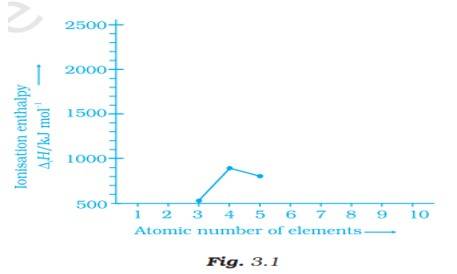Class 11th
Get insights from 8k questions on Class 11th, answered by students, alumni, and experts. You may also ask and answer any question you like about Class 11th
Follow Ask QuestionQuestions
Discussions
Active Users
Followers
New answer posted
5 months agoContributor-Level 10
This is a Short Answer Type Questions as classified in NCERT Exemplar
The characteristics properties of p-block elements are as follows:-
(i) It contain metals, nonmetals and metalloids
(ii) Mostly involved in covalent bonding
(iii) Some elements show variable oxidation state
(iv) It possesses relatively higher ionization enthalpy compared to the s-block elements.
New answer posted
5 months agoContributor-Level 10
This is a Short Answer Type Questions as classified in NCERT Exemplar
(i) C has the highest ionization energy among the given elements as along the period ionization enthalpy increases whereas it decreases down the group.
(ii) Al is the most metallic element among the given elements because down the group metallic character increases
New answer posted
5 months agoContributor-Level 10
This is a Short Answer Type Questions as classified in NCERT Exemplar

New answer posted
5 months agoContributor-Level 10
This is a Short Answer Type Questions as classified in NCERT Exemplar
Group | 1 |
Valency | 1 |
Outermost electronic configuration | 8s1 |
Formula of Oxide | M2O |
New answer posted
5 months agoContributor-Level 10
This is a Short Answer Type Questions as classified in NCERT Exemplar
Transition elements are named so because they form a bridge between s-block elements and p-block elements. Zn, Cd and Hg are among those elements that are dblock elements but they do not exhibit most of the properties of transition elements.
New answer posted
5 months agoContributor-Level 10
This is a Short Answer Type Questions as classified in NCERT Exemplar
As the atomic size of F is much smaller which leads to high e- - e - repulsion upon addition of electrons thus its electron gain enthalpy is less than that of Cl.
New answer posted
5 months agoContributor-Level 10
This is a Long Answer Type Questions as classified in NCERT Exemplar
Ans: As we move across the periodic table the ionization energy increases because of the increase in the effective nuclear charge and decrease of the shielding effect as more and more electrons get added in the same orbital.
Thus group 1 has lower ionization enthalpy compared to that of group 17 and also group 1 by losing one electron it will acquire the nearest noble gas electronic configuration which also contributes towards its lower ionization enthalpy.
New answer posted
5 months agoContributor-Level 10
This is a Long Answer Type Questions as classified in NCERT Exemplar
The following points make long form of periodic table better than Mendeleev's periodic table :-
(a) It is a periodic function of atomic number
(b) Elements are grouped as per there outermost electronic configuration
(c) Proper segregation of metals and non-metals
(d) More appropriate position of group VII.
New answer posted
5 months agoContributor-Level 10
This is a Long Answer Type Questions as classified in NCERT Exemplar
Mendeleev's arranged the elements as the periodicity of their atomic weights.
The drawbacks of Mendeleev's periodic table are as follows:-
(a) The position of hydrogen in the periodic table is not specified
(b) Isotopes are not included in the periodic table
(c) Elements with higher atomic mass are placed before the elements with lower atomic mass. For e.g- Co & Ni
(d) Gaps are left in his table considering the fact that more elements are yet to be discovered
(e) Inappropriate position of group VII.
New answer posted
5 months agoContributor-Level 10
This is a Long Answer Type Questions as classified in NCERT Exemplar
The group 1 elements are called alkali metals which possess outermost electronic configuration as ns1 .All the elements that have same outermost electron configuration possess similar properties and are placed in the same group.
Atomic number | Symbol | Electronic Configuration |
|
3 | Li | 1s2 2s1 | [He]2s1 |
11 | Na | 1s2 2s2 2p6 3s2 | [Ne]3S1 |
19 | K | 1s2 2s2 2p6 3s2 4s1 | [Ar]4S1 |
37 | Rb | 1s2 2s2 2p6 3s2 3d10 4s2 4p6 5s1 | [Kr]5S1 |
55 87 | Cs Fr | 1s2 2s2 2p6 3s2 3d10 4s2 4p6 5d10 5s2 5p6 6s1 | [Xe]6s1 [Rn]7s1 |
Taking an Exam? Selecting a College?
Get authentic answers from experts, students and alumni that you won't find anywhere else
Sign Up on ShikshaOn Shiksha, get access to
- 65k Colleges
- 1.2k Exams
- 679k Reviews
- 1800k Answers

